MCAT Exam > MCAT Questions > Which of the following vector combinations wi...
Start Learning for Free
Which of the following vector combinations will result in the least amount of displacement? (Note: Vectors  have magnitudes double that of vectors
have magnitudes double that of vectors 
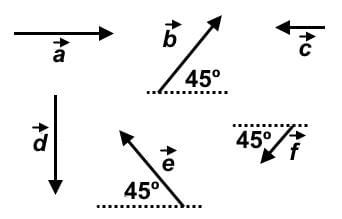
 have magnitudes double that of vectors
have magnitudes double that of vectors 

- a)

- b)

- c)

- d)

Correct answer is option 'B'. Can you explain this answer?
Verified Answer
Which of the following vector combinations will result in the least am...
Let’s consider each case graphically to narrow down our choices. Recall that vectors  are half the magnitude of vector
are half the magnitude of vector  By drawing out
By drawing out  we can see that the displacement is somewhat large:
we can see that the displacement is somewhat large:
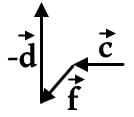
 are half the magnitude of vector
are half the magnitude of vector  By drawing out
By drawing out  we can see that the displacement is somewhat large:
we can see that the displacement is somewhat large:
All three vectors have the same magnitude here. By drawing out  , we can see that displacement is not large, but could be closer to zero:
, we can see that displacement is not large, but could be closer to zero:
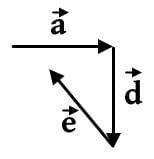
Between the remaining two, it becomes hard to discern visually which has the least displacement:
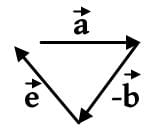
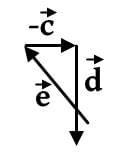
In analyzing let’s pick 10 for the magnitude of each vector, and resolve all the vectors into the x and y direction. In a 45 − 45 − 90 triangle, remember that the sides are in a proportion of 1 : 1 : √2 so with the hypotenuse as 10 units, the x and y components are 5√2, units. In the x-direction, the x component vectors
let’s pick 10 for the magnitude of each vector, and resolve all the vectors into the x and y direction. In a 45 − 45 − 90 triangle, remember that the sides are in a proportion of 1 : 1 : √2 so with the hypotenuse as 10 units, the x and y components are 5√2, units. In the x-direction, the x component vectors  overlap and add up to 10 √2, which is opposed by vector
overlap and add up to 10 √2, which is opposed by vector  , with, vector, on top, with a magnitude of 10.
, with, vector, on top, with a magnitude of 10.
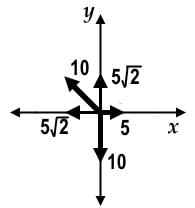
In the y-direction, the y-component of vectors cancel each other out. The resultant vector points in the negative y-direction with an approximate magnitude of 4 since √2, is approximately equal to 1.4.
cancel each other out. The resultant vector points in the negative y-direction with an approximate magnitude of 4 since √2, is approximately equal to 1.4.
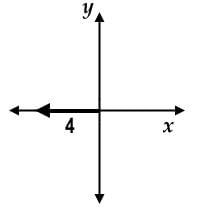
In analyzing let’s pick 10 for the magnitude of vectors
let’s pick 10 for the magnitude of vectors  and 5 for the magnitude of vector
and 5 for the magnitude of vector  resolve all the vectors into the x and y components. Vector
resolve all the vectors into the x and y components. Vector  resolves into an x and y components with magnitudes of 5√2 units:
resolves into an x and y components with magnitudes of 5√2 units:
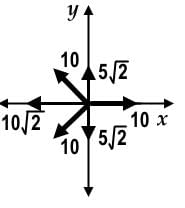
The resultant x-component is 2 in the negative-x direction, and the resultant y-component is 3 in the negative-y direction. To find our displacement, use the Pythagorean theorem to obtain √13 which is less than 4.
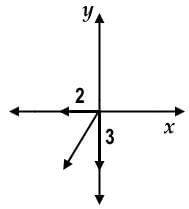
 , we can see that displacement is not large, but could be closer to zero:
, we can see that displacement is not large, but could be closer to zero:
Between the remaining two, it becomes hard to discern visually which has the least displacement:


In analyzing
 let’s pick 10 for the magnitude of each vector, and resolve all the vectors into the x and y direction. In a 45 − 45 − 90 triangle, remember that the sides are in a proportion of 1 : 1 : √2 so with the hypotenuse as 10 units, the x and y components are 5√2, units. In the x-direction, the x component vectors
let’s pick 10 for the magnitude of each vector, and resolve all the vectors into the x and y direction. In a 45 − 45 − 90 triangle, remember that the sides are in a proportion of 1 : 1 : √2 so with the hypotenuse as 10 units, the x and y components are 5√2, units. In the x-direction, the x component vectors  overlap and add up to 10 √2, which is opposed by vector
overlap and add up to 10 √2, which is opposed by vector  , with, vector, on top, with a magnitude of 10.
, with, vector, on top, with a magnitude of 10.
In the y-direction, the y-component of vectors
 cancel each other out. The resultant vector points in the negative y-direction with an approximate magnitude of 4 since √2, is approximately equal to 1.4.
cancel each other out. The resultant vector points in the negative y-direction with an approximate magnitude of 4 since √2, is approximately equal to 1.4.
In analyzing
 let’s pick 10 for the magnitude of vectors
let’s pick 10 for the magnitude of vectors  and 5 for the magnitude of vector
and 5 for the magnitude of vector  resolve all the vectors into the x and y components. Vector
resolve all the vectors into the x and y components. Vector  resolves into an x and y components with magnitudes of 5√2 units:
resolves into an x and y components with magnitudes of 5√2 units:
The resultant x-component is 2 in the negative-x direction, and the resultant y-component is 3 in the negative-y direction. To find our displacement, use the Pythagorean theorem to obtain √13 which is less than 4.


|
Explore Courses for MCAT exam
|

|
Question Description
Which of the following vector combinations will result in the least amount of displacement? (Note: Vectorshave magnitudes double that of vectorsa)b)c)d)Correct answer is option 'B'. Can you explain this answer? for MCAT 2025 is part of MCAT preparation. The Question and answers have been prepared according to the MCAT exam syllabus. Information about Which of the following vector combinations will result in the least amount of displacement? (Note: Vectorshave magnitudes double that of vectorsa)b)c)d)Correct answer is option 'B'. Can you explain this answer? covers all topics & solutions for MCAT 2025 Exam. Find important definitions, questions, meanings, examples, exercises and tests below for Which of the following vector combinations will result in the least amount of displacement? (Note: Vectorshave magnitudes double that of vectorsa)b)c)d)Correct answer is option 'B'. Can you explain this answer?.
Which of the following vector combinations will result in the least amount of displacement? (Note: Vectorshave magnitudes double that of vectorsa)b)c)d)Correct answer is option 'B'. Can you explain this answer? for MCAT 2025 is part of MCAT preparation. The Question and answers have been prepared according to the MCAT exam syllabus. Information about Which of the following vector combinations will result in the least amount of displacement? (Note: Vectorshave magnitudes double that of vectorsa)b)c)d)Correct answer is option 'B'. Can you explain this answer? covers all topics & solutions for MCAT 2025 Exam. Find important definitions, questions, meanings, examples, exercises and tests below for Which of the following vector combinations will result in the least amount of displacement? (Note: Vectorshave magnitudes double that of vectorsa)b)c)d)Correct answer is option 'B'. Can you explain this answer?.
Solutions for Which of the following vector combinations will result in the least amount of displacement? (Note: Vectorshave magnitudes double that of vectorsa)b)c)d)Correct answer is option 'B'. Can you explain this answer? in English & in Hindi are available as part of our courses for MCAT.
Download more important topics, notes, lectures and mock test series for MCAT Exam by signing up for free.
Here you can find the meaning of Which of the following vector combinations will result in the least amount of displacement? (Note: Vectorshave magnitudes double that of vectorsa)b)c)d)Correct answer is option 'B'. Can you explain this answer? defined & explained in the simplest way possible. Besides giving the explanation of
Which of the following vector combinations will result in the least amount of displacement? (Note: Vectorshave magnitudes double that of vectorsa)b)c)d)Correct answer is option 'B'. Can you explain this answer?, a detailed solution for Which of the following vector combinations will result in the least amount of displacement? (Note: Vectorshave magnitudes double that of vectorsa)b)c)d)Correct answer is option 'B'. Can you explain this answer? has been provided alongside types of Which of the following vector combinations will result in the least amount of displacement? (Note: Vectorshave magnitudes double that of vectorsa)b)c)d)Correct answer is option 'B'. Can you explain this answer? theory, EduRev gives you an
ample number of questions to practice Which of the following vector combinations will result in the least amount of displacement? (Note: Vectorshave magnitudes double that of vectorsa)b)c)d)Correct answer is option 'B'. Can you explain this answer? tests, examples and also practice MCAT tests.

|
Explore Courses for MCAT exam
|

|
Signup for Free!
Signup to see your scores go up within 7 days! Learn & Practice with 1000+ FREE Notes, Videos & Tests.























